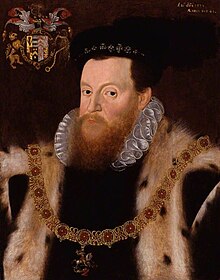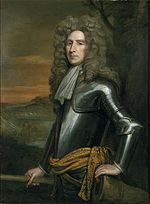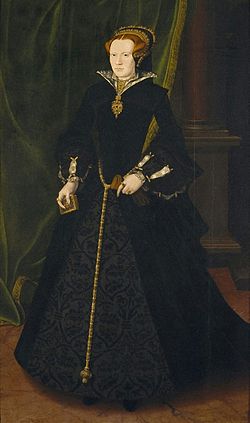Sir Henry Sidney (1529 â€" 5 May 1586), Lord Deputy of Ireland, was the eldest son of Sir William Sidney of Penshurst, a prominent politician and courtier during the reigns of Henry VIII and Edward VI, from both of whom he received extensive grants of land, including the manor of Penshurst in Kent, which became the principal residence of the family.
Henry Sidney was brought up at court as the companion of Prince Edward, afterwards King Edward VI, and he continued to enjoy the favour of the Crown, particularly throughout the reign of Queen Elizabeth I.
Marriage and family

Sidney married Mary Dudley, eldest daughter of John Dudley, 1st Duke of Northumberland, in 1551. They would have three sons and four daughters. His eldest son was Sir Philip Sidney, and his second was Robert Sidney, 1st Earl of Leicester.
His daughter Mary Sidney married Henry Herbert, 2nd Earl of Pembroke, and by reason of her literary achievements was one of the most celebrated women of her time.
Career

First trip to Ireland
In 1556 Sidney served in Ireland with the lord deputy, Thomas Radclyffe, 3rd Earl of Sussex, who in the previous year had married his sister Frances. Sidney had a large share in the administration of the country, especially in the military measures taken by his brother-in-law for bringing Irish chieftains into submission to the English Crown. In the course of the lord deputy's expedition to Ulster in 1557 Sidney devastated the island of Rathlin. In the following year, during the absence of Sussex in England, he had sole responsibility for the government of Ireland and conducted himself with marked ability. A second absence of the lord deputy from Ireland, on the accession of Queen Elizabeth, threw the chief control into Sidney's hands at the outbreak of trouble with Shane O'Neill, and he displayed great skill in temporising with the chieftain until Sussex reluctantly returned to his duties in August 1559. About the same time Sidney resigned his office of vice-treasurer of Ireland on his appointment as president of the council of the Marches in Wales, and for the next few years he resided chiefly at Ludlow Castle, with frequent visits to the court in London.
Lord deputy
In 1565 Sidney was appointed lord deputy of Ireland in place of Sir Nicholas Arnold, who had succeeded the earl of Sussex in the previous year. He found the country in a more impoverished and more turbulent condition than when he left it, the chief disturbing factor being Shane O'Neill in Ulster. With difficulty he persuaded Elizabeth to sanction vigorous measures against O'Neill; and although the latter successfully avoided a decisive encounter, Sidney restored O'Neill's rival Calvagh O'Donnell to his rights, and established an English garrison at Derry which maintained some degree of order.
In 1567 Shane was murdered by the MacDonnells of Antrim, and Sidney turned his attention to the south, where with vigour and determination he arranged the quarrel between Gerald FitzGerald, 15th Earl of Desmond, and Thomas Butler, 10th Earl of Ormond, and laid his hand heavily on other disturbers of the peace; then, returning to Ulster, he compelled Turlough Luineach O'Neill, Shane's successor in the clan chieftainship, to make submission, and placed garrisons at Belfast and Carrickfergus to overawe Tyrone and the Glynns.
Desmond Rebellions
In the autumn of 1567 Sidney returned to England, and was absent from Ireland for the next ten months. On his return he urged upon Cecil the necessity for measures to improve the economic condition of Ireland, to open up the country by the construction of roads and bridges, to replace the Ulster tribal institutions by a system of freehold land tenure, and to repress the ceaseless disorder prevalent in every part of the island. In 1569, he oversaw the opening of parliament, the first to be held for ten years. He proposed the establishment of the Court of Castle Chamber â€" an Irish version of the Star Chamber â€" which drew the encouragement of the Queen and was established after his recall.
Sidney proposed the appointment of a military governor ("Lord President") in the provinces of Munster and Connacht. This provoked the first of the Desmond Rebellions led by James Fitzmaurice Fitzgerald of the Geraldine family, which had been put down with great severity by 1573. Sidney turned on the Butlers in Ormond and Kilkenny, who had revolted against the opportunistic claims to their lands by Sir Peter Carew, an adventurer from Devon who pursued his entitlement with the blessing of the Dublin government. In 1570 many followers of Sir Edmund Butler were hanged, and three brothers of Thomas Butler, 3rd Earl of Ormonde, were attainted by an act of the Irish parliament.
Sidney left Ireland in 1571, aggrieved by the slight appreciation of his statesmanship shown by Queen Elizabeth. In September 1575 he returned with greater royal authority, to find matters in a worse state than before. In Antrim the MacQuillans of the Route and Sorley Boy MacDonnell were the chief fomenters of disorder, and after pacifying this northern territory Sidney repaired to the south, where he was equally successful in making his authority respected. He left his mark on the administrative areas of the island by installing certain shire divisions on the English model.
At an earlier period he had combined the districts of the Ardes and Clandeboye to form the county of Carrickfergus, and had converted the country of the O'Farrells into the County Longford. He then carried out a similar policy in Connacht, where the ancient Irish district of Thomond became County Clare, and the counties of Galway, Mayo, Sligo and Roscommon were also delimited.
Sidney also suppressed a rebellion headed by the earl of Clanricarde and his sons in 1576, and hunted Rory O'More to his death two years later. Meantime Sidney's annual levy (the cess), which was designed to fund a central government militia, had caused discontent among the gentry of the Pale, who carried their grievances to queen Elizabeth. Greatly to Sidney's chagrin the queen censured his extravagance. He was recalled in September 1578, and was coldly received by Elizabeth.
Later years
From his position on the Privy Council at London, Sidney used his influence in the bloody suppression of the Second Desmond Rebellion, which led to great loss of life in Munster in the period 1579â€"83, and ultimately to the plantation of the province with settler and planter families.
He lived chiefly at Ludlow Castle for the remainder of his life, performing his duties as president of the Welsh Marches.
See also

- Rathlin Island Massacre
Sources
- Holinshed's Chronicles, vol. iii. (6 vols., London, 1807).
- Calendar of Ancient Records of Dublin, edited by J. T. Gilbert, vols. i. and ii. (Dublin, 1889).
- J. T. Gilbert, History of the Viceroys of Ireland (Dublin, 1865).
- J. A. Froude, History of England 12 vols. (London, 1856â€"1870).
- Richard Bagwell, Ireland under the Tudors, 3 vols. (London, 1885â€"1890).
- John O'Donovan (ed.) Annals of Ireland by the Four Masters (1851).
- Calendar of State Papers: Carew MSS 6 vols (London, 1867â€"1873).
- Calendar of State Papers: Ireland (London)
- Colm Lennon Sixteenth Century Ireland â€" The Incomplete Conquest (Dublin, 1995) ISBN 0-312-12462-7.
- Nicholas P. Canny The Elizabethan Conquest of Ireland: A Pattern Established, 1565â€"76 (London, 1976) ISBN 0-85527-034-9.
- N. P. Canny Making Ireland British, 1580â€"1650 (Oxford University Press, 2001) ISBN 0-19-820091-9.
- Steven G. Ellis Tudor Ireland (London, 1985) ISBN 0-582-49341-2.
- Cyril Falls Elizabeth's Irish Wars (1950; reprint London, 1996) ISBN 0-09-477220-7.
- Gerard A. H. McCoy Irish Battles (Belfast, 1989) ISBN 0-86281-212-7.
- Thomas Rymer: Foedera (2.ed., London, 1726â€"35), vol.XV, p. 746-8 et pass.
References
-  This article incorporates text from a publication now in the public domain: Chisholm, Hugh, ed. (1911). Encyclopædia Britannica (11th ed.). Cambridge University Press.Â
